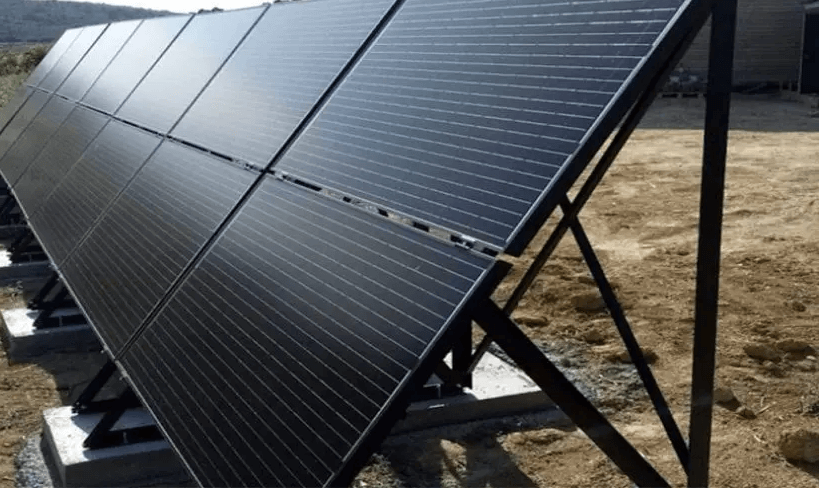Class B – Stand-alone Solar panels for a house or flats
If it is not possible to erect solar panels on a roof or wall of a dwelling or block of flats using Class A, you can erect them as a stand-alone solar panels within the curtilage of a dwelling or a block of flats without planning permission.
However there are a few restrictions, before you start erecting a solar farm in the field next door!

This was extended in December 2023 under SI 2023/1279 to allow for the development of stand-alone solar equipment within the curtilage of domestic buildings in conservation areas where it is installed closer to the highway than the dwellinghouse.
In these cases, the solar equipment can be no higher than 2 metres and is subject to prior approval with regard to the impact of the appearance of the solar equipment on the character of the conservation area. Full details are in the legislation below – or engage Planning Geek to apply on your behalf.
Restrictions for stand-alone solar panels?
As expected there are a few restrictions. You can only have one installation of solar within the curtilage of the dwelling or a block of flats. This must not exceed more than 4 metres in height or within 5 metres of a boundary. The total surface of the panels must not exceed 9 sq metres and no dimension must exceed 3 metres in height width or depth.
If the dwelling is in a conservation area or a world heritage site then it must not be between the dwelling or flats and the highway.
You cannot install these in a listed building without full planning permission.
Note that the curtilage is just that – it can’t be in a field to the side of the property – it must be in the domestic curtilage.
Legislation
Class B – installation or alteration etc of stand-alone solar equipment on domestic premises
Permitted development
B. The installation, alteration or replacement of stand-alone solar for microgeneration within the curtilage of a dwellinghouse or a block of flats.
Development not permitted
B.1 Development is not permitted by Class B if—
(a) in the case of the installation of stand-alone solar, the development would result in the presence within the curtilage of more than 1 stand-alone solar;
(b) any part of the stand-alone solar—
(i) would exceed 4 metres in height or, in the case of stand-alone solar on land in a conservation area which would be installed so that it is nearer to any highway which bounds the curtilage than the part of the dwellinghouse or block of flats which is nearest to that highway, 2 metres in height;
(ii) would, in the case of land which is a World Heritage Site, be installed so that it is nearer to any highway which bounds the curtilage than the part of the dwellinghouse or block of flats which is nearest to that highway;
(iii) would be installed within 5 metres of the boundary of the curtilage;
(iv) would be installed within the curtilage of a listed building; or
(v) would be installed on a site designated as a scheduled monument; or
(c) the surface area of the solar panels forming part of the stand-alone solar would exceed 9 square metres or any dimension of its array (including any housing) would exceed 3 metres.
Conditions
B.2 Development is permitted by Class B subject to the following conditions—
(a) stand-alone solar is, so far as practicable, sited so as to minimise its effect on the amenity of the area;
(aa) in the case of stand-alone solar installed in a conservation area nearer to any highway which bounds the curtilage than the part of the dwellinghouse or block of flats which is nearest to that highway, before beginning development the developer must apply to the local planning authority for a determination as to whether the prior approval of the local planning authority will be required with respect to the impact of the appearance of the stand-alone solar on the character of the conservation area;
(ab) in relation to an application under sub-paragraph (aa), paragraphs J.4(3) to J.4(12) of this Part apply as if “Class B” substitutes the reference to “Class J” in paragraph J.4(4); and [included below]
(b) stand-alone solar is removed as soon as reasonably practicable when no longer needed.
[section copied from Class J as referred to in sub-paragraph (ab)]
(3) The application must be accompanied by—
(a) a written description of the proposed development;
(b) a plan indicating the site and showing the proposed development;
(c) the developer’s contact address; and
(d) the developer’s email address if the developer is content to receive communications electronically;together with any fee required to be paid.
(4) The local planning authority may refuse an application where, in the opinion of the authority—
(a) the proposed development does not comply with, or
(b) the developer has provided insufficient information to enable the authority to establish whether the proposed development complies with,any conditions, limitations or restrictions specified in Class B applicable to the development in question.
(5) Sub-paragraphs (6) and (8) do not apply where a local planning authority refuses an application under sub-paragraph (4) and for the purposes of section 78 (appeals) of the Act such a refusal is to be treated as a refusal of an application for approval.
(6) The local planning authority must give notice of the proposed development—
(a) by site display in at least one place on or near the land to which the application relates for not less than 21 days of a notice which—
(i) describes the proposed development;
(ii) provides the address of the proposed development;
(iii) specifies the date by which representations are to be received by the local planning authority; or(b) by serving a notice in that form on any adjoining owner or occupier.
(7) The local planning authority may require the developer to submit such information as the authority may reasonably require in order to determine the application.
(8) The local planning authority must, when determining an application—
(a) take into account any representations made to them as a result of any notice given under sub-paragraph (6); and
(b) have regard to the National Planning Policy Framework issued by the Ministry of Housing, Communities and Local Government in February 2019 July 2021, so far as relevant to the subject matter of the prior approval, as if the application were a planning application.(9) The development must not begin before the occurrence of one of the following—
(a) the receipt by the applicant from the local planning authority of a written notice of their determination that such prior approval is not required;
(b) the receipt by the applicant from the local planning authority of a written notice giving their prior approval; or
(c) the expiry of 56 days following the date on which the application under sub-paragraph (3) was received by the local planning authority without the authority notifying the applicant as to whether prior approval is given or refused.(10) The development must be carried out—
(a) where prior approval is required, in accordance with the details approved by the local planning authority;
(b) where prior approval is not required, or where sub-paragraph (9)(c) applies, in accordance with the details provided in the application referred to in sub-paragraph (3),
unless the local planning authority and the developer agree otherwise in writing.(11) The local planning authority may grant prior approval unconditionally or subject to conditions reasonably related to the subject matter of the prior approval.
(12) When computing the number of days in paragraph (6)(a), any day which is a public holiday must be disregarded.
Stand-alone Solar Panels Page Updated: 7th December 2023



